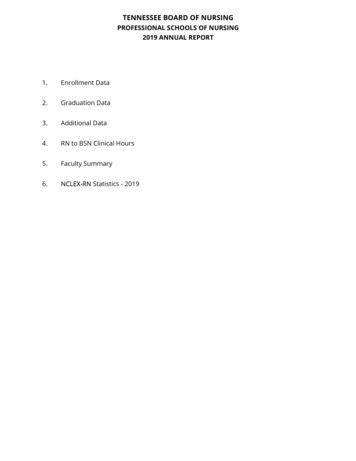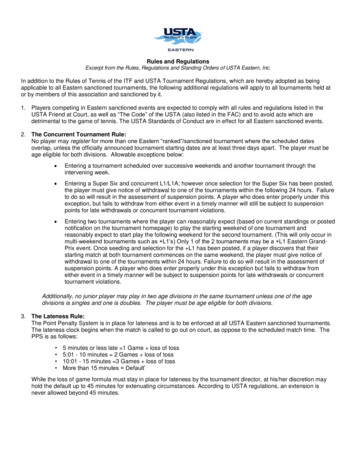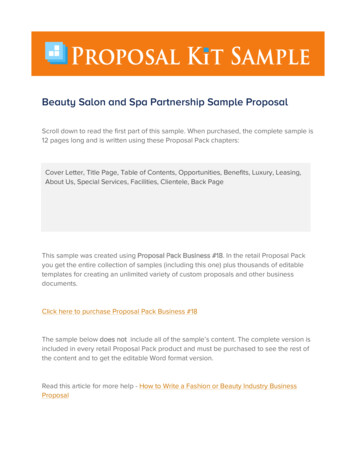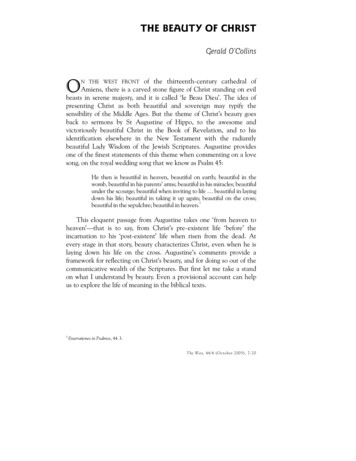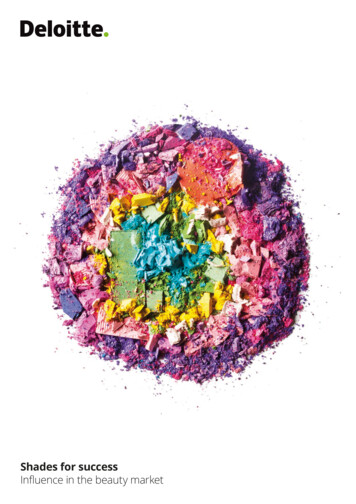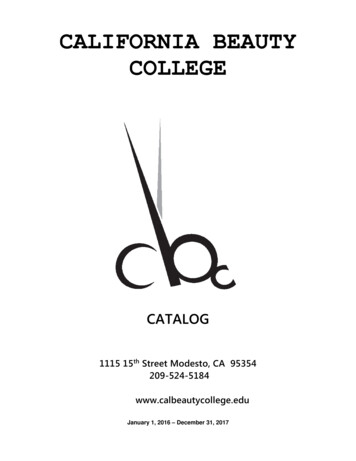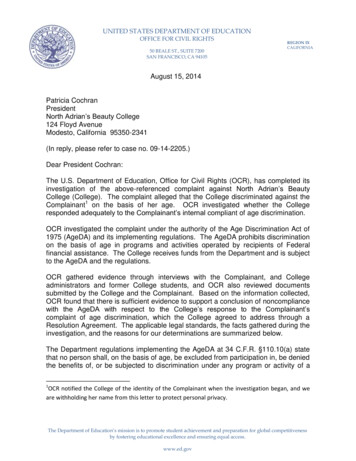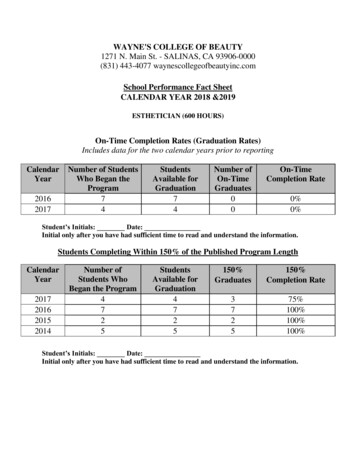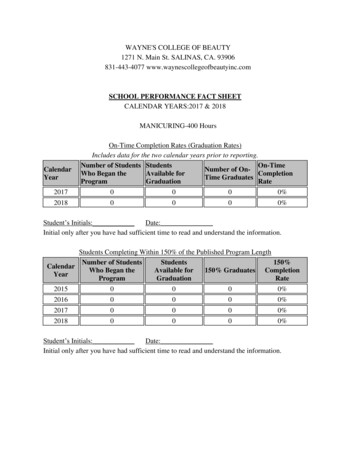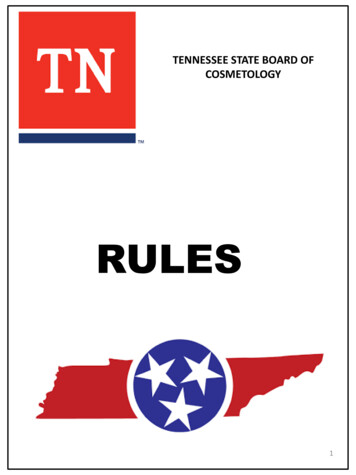
Transcription
TENNESSEE STATE BOARD OFCOSMETOLOGYRULES1
RULESOFTENNESSEE STATE BOARD OF COSMETOLOGY500 James Robertson ParkwayDavy Crockett TowerNashville, Tennessee 37243ChapterTitle0440-01 . . Licensing0440-02 Sanitary Rules0440-03 . . Rules of Procedure for Hearing Contested CasesADMINISTRATIVE HISTORYOriginal rules 0440-01-.01 through 0440-01-.35 were certified on June 10, 1974, under Chapter 491 of the PublicActs of 1974 as rules in effect when Chapter 491 became effective. The Administrative History following each rulegives the date on which the rule was certified and the date on which the rule was filed and its effective date, ifpromulgated after March 11, 1974. The Administrative History following each rule also shows the dates of anyamendments or repeals.Amendment to rule 0440-01-.35 filed February 13, 1975; effective March 15, 1975.Original rules 0440-01-.36 through 0440-01-.46 filed February 24, 1975; effective March 26, 1975.Chapter 0440-02 filed April 27, 1978; effective May 29, 1978.Chapter 0440-03 filed November 22, 1978; effective January 8, 1979.Repeal of chapters 0440-01 through 0440-02 and new rules 0440-01-01-.01 through 0440-01-01-.13 and 0440-0102-.01 through 0440-01-02-.20 filed February 23, 1983; effective March 25, 1983.Amendments to rules 0440-01-01-.09 through 0440-01-01-.13, 0440-01-02-.07, and new rules 0440-01-01-.08 and0440-01-01-.21 filed February 21, 1986; effective March 23, 1986.Amendments to rules 0440-01-01-.01, 0440-01-01-.09, and 0440-01-01-.10 and new rule 0440-01-01-.15 filedAugust 5, 1986; effective September 19, 1986.Amendments to rules 0440-01-01-.01, 0440-01-01-.03, 0440-01-01-.05, 0440-01-01-.06, 0440-01-01-.10 through0440-01-01-.12, 0440-01-02-.01, 0440-01-02-.07, and 0440-01-02-.08 filed August 21, 1987; effective October 5,1987.Amendments to rules 0440-01-01-.01, 0440-01-01-.03, 0440-01-01-.05, 0440-01-01-.07, 0440-01-01-.10, 0440-0101-.11, 0440-01-02-.03, and 0440-01-02-.07 filed January 13, 1989; effective February 27, 1989.Amendment to rule 0440-01-01-.14 filed July 14, 1989; effective August 28, 1989.Amendment to rule 0440-01-01-.15 filed July 10, 1990; effective August 24, 1990.Amendment to rule 0440-01-01-.14 filed May 1, 1991; effective June 15, 1991.Amendments to rules 0440-01-01-.01, 0440-01-01-.07, 0440-01-01-.09, 0440-01-01-.10, 0440-01-01-.14, 0440-0102-.08, 0440-01-02-.10, and original rule 0440-01-02-.22 filed August 17, 1992; effective October 1, 1992.July, 2017 (Revised) 2Repeal of 0400-01-01, 0440-01-02, and 0220-01-03 and new chapter 0440-01, 0440-02, and 0440-03 filed July 10,1997; effective September 23, 1997.Original rules 0440-02-.16 and 0440-02-.17 and amendment to rules 0440-01-.01, 0440-01-.04, 0440-01-.05, 044001-.07, 0440-01-.09, 0440-01-.11, 0440-01-.13, 0440-02-.01, 0440-02-.03, 0440-02-.04, 0440-02-.07, and 0440-02.13 filed May 25, 2004; effective August 8, 2004.New rule 0440-01-.15, repeal and new rule 0440-01-.03, and amendments to 0440-01-.01 and 0440-02-.10 filedMay 2, 2008; effective July 16, 2008.2
Amendments to rules 0440-01-.01, 0440-01-.03, 0440-01-.05, 0440-01-.06, 0440-01-.09, 0440-01-.11, 0440-01.13, 0440-01-.14, 0440-01-.15, 0440-02-.01, 0440-02-.04, 0440-02-.07, 0440-02-.08, 0440-02-.10, and new rules0440-01-.16, 0440-01-.17, and 0440-01-.18 filed September 2, 2015; effective December 1, 2015.Amendments to rules 0440-01-.03, 0440-01-.05, 0440-01-.06, and 0440-01-.11, filed March 9, 2017; effectiveJune 7, 2017.Amendments to rules 0440-02-.01, 0440-02-.03, and 0440-02-.13 filed March 9, 2017; effective June 7, 2017.Amendments to rule 0440-01-.13 filed March 9, 2017; effective June 7, 2017. However, the Board ofCosmetology and Barber Examiners filed a 23-day stay of the effective date of the rule April 28, 2017; neweffective date June 30, 2017.Emergency rules 0440-01-.13, 0440-01-.19, and 0440-02-.01 filed July 24, 2017; effective through January 20,2018.RULESOFTENNESSEE BOARD OF COSMETOLOGY AND BARBER EXAMINERSCHAPTER 0440-01LICENSINGTABLE OF CONTENTS0440-01-.01 Requirements for School License0440-01-.02 Change of School Ownership and Relocation0440-01-.03 Curriculum0440-01-.04 High School Equivalents0440-01-.05 Requirements for Schools0440-01-.06 Enrollment of Students0440-01-.07 Student Kits0440-01-.08 Expiration of School Registration Renewal0440-01-.09 Examination Passing Scores and School Attendance Ratio0440-01-.10 Original License Fee0440-01-.11 Teacher Training Programs0440-01-.12 Demonstrations0440-01-.13 Fees0440-01-.14 Civil Penalties0440-01-.15 Practice by Instructor0440-01-.16 Schools Providing Limited Instruction0440-01-.17 Communication with the Board0440-01-.18 Expedited Licensing for Certain Military Personnel and Spouses0440-01-.19 Mobile Shops0440-01-.01 REQUIREMENTS FOR SCHOOL LICENSE.(1) The Board of Cosmetology and Barbering Examiners (hereinafter the “Board”) will not issue, reissue, orrenew a license to operate a school of cosmetology unless the school is equipped with all workable equipmentconsisting of at least:(a) One (1) work station with adjustable chair per student working on the clinic floor with a minimum of twenty(20) stations;(b) Five (5) shampoo basins, with hot and cold running water, adequately spaced;(c) Five (5) manicure tables;(d) A minimum of five (5) working floor-based hooded dryers;(e) Ten (10) mannequins;(f) One (1) straight chair in the theory classroom for each student attending the class;(g) One (1) wet sterilizer at each student work station;(h) One (1) enclosed storage area for clean towels;(i) One (1) covered container for soiled towels;(3
j) One (1) covered trash container maintained in a sanitary condition;(k) Dry sterilizer at each student work station;(l) Ultra violet sanitizer;(m) Time sheet/time clock; and(n) Access to a minimum of two (2) restrooms.(2) A school of cosmetology offering an aesthetics curriculum shall also be equipped with all workableequipment consisting of at least:(a) Sufficient facial steamers;(b) One (1) suction machine or a Level I or II Microdermabrasion machine;(c) One (1) light based device with the manufacturer’s intended commercial use statement for hairremoval and skin enhancement of face and body;(d) Sufficient protective eyewear (glasses) recommended by manufacturer of laser/light devices foreach student and instructor;(e) One (1) LED light with the manufacturers intended use statement for skin improvement;(f) One (1) wax depilatory heater pot with manufacturer’s intended commercial use statement;(g) One (1) hands free magnifying lamp;(h) One (1) hot towel cabin;(i) One (1) reclining facial chair/table;(j) One (1) electric brushing machine or sonic brushing device;(k) One (1) sink which provides hot and cold running water other than the bathroom;(l) One (1) ultraviolet sanitizer;(m) One (1) covered trash container maintained in a sanitary condition at each teaching station;(n) Sufficient work area for each student;(o) One (1) covered and labeled container for soiled towels;(p) One (1) wet sterilizer;(q) One (1) professional makeup station representing a color matrix palette of makeup products;(r) Sufficient disposable applicators for makeup application;(s) One (1) skin care product kit containing two products from each category: cleansers, astringentand toners, moisturizer, problem prep, and protective products;(t) One (1) Autoclave instrument sanitizer;(u) One (1) sharps container for biohazard material removal;(v) One (1) blood spill kit; and(w) All containers for cosmetic products must be properly labeled.(3) Requirements for Instructional Floor Space(a) “Instructional floor space” means the floor space of a school designated primarily for the instructionof students and shall not include such spaces as storage, restrooms, utility rooms, passageways, orinhabited administrative spaces such as reception areas, offices and break areas.(b) A school of cosmetology offering a manicuring curriculum shall also be equipped with adequateinstructional floor space for manicuring so as not to compromise or disrupt the teaching of cosmetologycurriculum prescribed in Rule 0440-01-.03.(c) A school of cosmetology offering a natural hair styling curriculum shall also be equipped withadequate instructional floor space for natural hair styling so as to not compromise or disrupt theteaching of cosmetology curriculum prescribed in Rule 0440-01-.03.(d) A school of cosmetology offering a shampooing curriculum shall also be equipped with adequateinstructional floor space for shampooing so as to not compromise or disrupt the teaching ofcosmetology curriculum prescribed in Rule 0440-01-.03.(e) A school of cosmetology offering an aesthetics curriculum shall also be equipped with adequateinstructional floor space for aesthetics so as not to compromise or disrupt the teaching of cosmetologycurriculum prescribed in Rule 0440-01-.03.4
(4) Floor Plan(a) A proposed floor plan must be submitted to and approved by the Board before:1. Issuance of a license to operate a new school of cosmetology;2. Issuance of a license to operate a school of cosmetology whose ownership has changed;3. Reissuance of a license to operate a relocated school of cosmetology;(b) For all schools other than specialized schools as described in subparagraph (4)(c), below, thefloor plan shall provide for, and the school shall contain, at least 2200 square feet of instructionalfloor space, including an enclosed classroom for theory instruction.(c) The floor plan for a specialized school solely offering a course of study in aesthetics, manicuring, ornatural hair styling shall provide for, and the school shall contain adequate floor space as determined bythe Board.(5) New School(a) A new school shall be closed to the public for ninety (90) days after the issuance of its license unlessthe school has students enrolled with the required two hundred (200) or more hours to performcosmetology services on the public.(b) A branch school shall be considered a new school unless the school has students enrolled with therequired two hundred (200) or more hours to perform cosmetology services on the public.(c) If an existing school requires an expansion campus facility, the facility must be located within two (2)miles of the main campus.(d) A specialized school solely offering a course of study in aesthetics, manicuring, or natural hair styling shallhave a minimum of five (5) students.Authority: T.C.A. §§ 62-4-105(e), 62-4-120(f), 62-4-122, 62-4-122(g)(2), 62-4-116, and 62-4-117. AdministrativeHistory: Original rule certified June 10, 1974. Repeal and new rule filed February 23, 1983; effective March 25,1983. Amendment filed August 5, 1986; effective September 19, 1986. Amendment filed August 21, 1987;effective October 5, 1987. Amendment filed January 13, 1989; effective February 27, 1989. Amendment filedAugust 17, 1992; effective October 1, 1992. Repeal and new rule filed July 10, 1997; effective September 23, 1997.Amendment filed May 25, 2004; effective August 8, 2004. Amendment filed May 2, 2008; effective July 16, 2008.Amendment filed September 2, 2015; effective December 1, 2015.0440-01-.02 CHANGE OF SCHOOL OWNERSHIP AND RELOCATION.(1) The Board shall be notified within ten (10) days of the effective date of any change in ownership or name of aschool of cosmetology.(2) For purposes of Tenn. Code Ann. §62-4-120(e) and this paragraph, any substantial addition to a school shall bedeemed to constitute a relocation thereof;Authority: T.C.A. §§ 62-4-105(e) and 62-4-120. Administrative History: Original rule certified June 10, 1974.Repeal and new rule filed February 23, 1983; effective March 25, 1983. Amendment filed August 21, 1987;effective October 5, 1987. Repeal and new rule filed July 10, 1997; effective September 23, 1997.0440-01-.03 CURRICULUM.(1) “Apprenticeship student” means a student enrolled in a school participating in an apprenticeship programwith the intention of completing the school’s curriculum under that school’s apprenticeship program.(2) “Supervising licensed professional” means a licensee in the field of study of an enrolled apprenticeshipstudent who is in responsible charge of supervising and accounting for that student’s apprenticeship programcreditable activities and providing the participating school with the student’s apprenticeship activity record.(3) (a) The fifteen hundred (1,500) clock hours/ 45 credit hours of instruction required ofapplicants for a license to practice cosmetology shall be apportioned as follows:1. General 300 clock hours/ 9 credit hours Sterilization, sanitation and bacteriology,anatomy and physiology, shop ethics, personality and salesmanship, state law.2. Chemical . .600 clock hours/ 18 credit hours Permanent waves, hair relaxer, haircoloring, bleaching and toning, sculptured nails, hair structure and chemistry.3. Physical . .600 clock hours/ 18 credit hours Shampooing and rinses, hair and scalpcare, hair shaping, hairdressing and styling, facials, arching, lash and brow tinting, manicures and pedicures. (b)The six hundred (600) clock hours/ 18 credit hours of instruction required of an5applicant for a license to practice manicuring shall be apportioned as follows:
1. General 150 clock hours/ 4.5 credit hours Sterilization, sanitationand bacteriology, anatomy and physiology, state law, salon management, and ethics.2. Chemical . .100 clock hours/ 3 credit hours Product knowledge,ingredients and usage of materials, manicuring and pedicuring, EPA and OSHA requirements.3. Physical . .350 clock hours/ 10.5 credit hours Massage, manicuring,pedicuring, nail care, nail artistry, nail wraps, sculptured nails, nail tips, gel nails, and nail safety.(c) The seven hundred and fifty (750) clock hours/ 22.5 credit hours of instruction requiredof an applicant for a license to practice aesthetics shall be apportioned as follows:1. General 150 clock hours/ 4.5 credit hours Sterilization, sanitationand bacteriology, professional ethics, personality, salesmanship, anatomy and physiology, and state law.2. Chemical . .150 clock hours/ 4.5 credit hoursSkin conditions and disorders, nutrition, aging factors, product ingredients and usage, waxing, lash andbrow tinting, OSHA and EPA requirements.3. Physical . 450 clock hours/ 13.5 credit hours Massage movementsand manipulations, masks and packs, facial treatments with and without the use of machines, skinanalysis and consultation, application of all products and machines, color psychology, make-up andcorrective make-up arching.(d) The three hundred (300) clock hours/ 9 credit hours of instruction required of anapplicant for a license to practice shampooing shall be apportioned as follows:1. General . .100 clock hours/ 3 credit hours Sanitation, sterilization,bacteriology, anatomy, physiology, state law, shampooing and draping, hair and scalp massage.2. Chemical . . .50 clock hours/ 1.5 credit hours Chemistry andcomposition of shampoos and conditioners, product knowledge, EPA and OSHA requirements.3. Physical . .150 clock hours/ 4.5 credit hoursHair and scalp massage, hair and scalp care, shampooing and rinsing foreign material from hair, shopmanagement (answering phone, scheduling appointments, ordering supplies, taking inventory, and sellingto clients).(e) The three hundred (300) clock hours/ 9 credit hours of instruction required of anapplicant for a natural hair stylist license shall be apportioned as follows:1. General 120 clock hours/ 3.6 credit hours Sanitation, sterilization,bacteriology, shampooing, draping, disorders of hair and scalp, state law and salon management.2. Physical . .180 clock hours/ 5.4 credit hoursTwisting, wrapping, weaving, extending, locking, braiding and natural hair styling,by hand or mechanical appliances.(f) The three hundred (300) clock hours/ 9 credit hours of instruction required of applicantsfor an instructor’s license shall include no less than a total of one hundred (100) clock hours/ 3 credit hoursin lesson planning and motivation.(4) To the extent that the prescribed curricula for courses of instruction are substantially similar, the Boardmay allow general hours of credit accumulated by a student to be transferred from one course ofinstruction to another. A student shall be allowed to transfer hours only once.(5) Any person holding a valid Tennessee Master Barber certificate of registration may appear before theboard and request to sit for the Cosmetology Exam. The board may approve the applicant to test if they:(a) Complete three hundred (300) cosmetology school hours at a licensed cosmetology school learningthe fundamentals of cosmetology technique and pedicuring. This student will be given credit for theremaining twelve hundred (1200) hours required to obtain a Tennessee cosmetology license uponfinishing the required 300 hours in a cosmetology school; or(b) Held a master barber certificate of registration in Tennessee or another jurisdiction with reciprocity withTennessee for five (5) continuous years.6
(6) Notwithstanding any provision to the contrary, any school operated under the TennesseeCosmetology Act of 1986 may develop courses of instruction and practice incorporating anapprenticeship curriculum, which allows an applicant to obtain fifty percent (50%) of the required hours fora specific license through classroom instruction and fifty percent (50%) of the required hours under thedirect supervision and responsible charge of a licensed professional who meets the requirements setforth in this rule. Supervised apprenticeship hours may not be used for credit for more than fifty percent(50%) of the required hours in any instruction subcategory (General, Chemical or Physical).(a) For purposes of this rule, “supervising licensed professional” shall identify a licensed professional insupervision of a student enrolled in an apprenticeship program curriculum, approved by the Board, andresponsible for all aspects of that student’s apprenticeship instruction.(b) Any school offering an apprenticeship curriculum shall maintain a record of all hours completed underthe apprenticeship program, including classroom hours, for which credit is awarded in a student’sacademic file. This record shall include the number of hours completed under direct supervision andresponsible charge, the dates these hours were earned, the license number of the professional inresponsible charge of instruction who directly supervised the student and the signatures of both thestudent and the supervising licensed professional in responsible charge.1. The required records shall be maintained in the student’s file and made available for inspection duringthe student’s academic career, shall be maintained for a period of not less than seven (7) years after astudent is no longer attending the school providing the apprenticeship curriculum, and shall be madeavailable to the Board immediately upon request during this time.2. A daily log accounting for all apprenticeship hours awarded under this chapter by any school offeringan apprenticeship curriculum shall be maintained by the school and updated monthly. This log shall bemade available for inspection at any time.3. The supervising licensed professional shall submit the daily log to the school providing theapprenticeship curriculum no later than the close of business of the first (1st) day of the month for theprevious month.4. Should an apprentice change salon, shop, establishment, or supervising licensed professional, anotarized transcript of the total hours accumulated shall be signed by the salon, shop, or establishmentowner or manager along with the supervising licensed professional and submitted to the approvingschool within ten (10) days of the change.(c) Any supervi
TENNESSEE BOARD OF COSMETOLOGY AND BARBER EXAMINERS CHAPTER 0440-01 LICENSING TABLE OF CONTENTS 0440-01-.01 Requirements for School License 0440-01-.02 Change of School Ownership and Relocation 0440-01-.03 Curriculum 0440-01-.04 High School Equivalents 0440-01-.05 Requirements for Schools 0440-01-.06 Enrollment of Students 0440-01-.07 Student KitsFile Size: 1MBPage Count: 81
